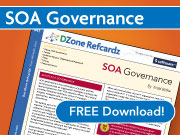 The Return of the ESB
The Return of the ESB

Just when you thought it was safe to build your SOA, the ESB has returned. A whitepaper from Paul Fremantle of WSO2 seems to have stirred the ESB pot once again, with a number of pundits chiming in on the future of the ESB. I was surprised at how little conversation there was about at the Gartner AADI Summit in comparison to the previous Gartner event I had attended two years prior, but that’s quickly changed.
I read Paul’s paper, and from my perspective, not much has changed from the views that I expressed two years ago back in a Burton Group Catalyst presentation and then in this followup blog post. The bulleted list of capabilities provided in that post aren’t ones that are going to go away, and it surprises me that there continues to be so much debate in this space.
Joe McKendrick recently summarized a number of recent comments in a blog entry, including ones from Roy Schulte of Gartner, Lief Davidson of IBM, ZDNet blogger Dana Gardner, and Lorraine Lawson of IT Business Edge (who has given a couple of my recent blogs some publicity, thanks for that). There were a couple things in Joe’s entry that just rubbed me the wrong way.
First is this notion of federated ESBs. Both Roy and Dana made comments around this, and I simply don’t agree. I’ll admit, there are a certain class of organizations that will have multiple ESBs. They’re the same organizations that have one of just about every technology because they’re so huge. Take them out of the equation, because I don’t believe they represent the masses. For the rest of us, what does “federated ESBs” mean? Does it mean that I have multiple ESBs performing redundant capabilities? Or does it mean that I partition up the capabilities across multiple products/devices, but yet with no two products providing the same capability, even though they may be capable of it? The latter is tolerable and likely, the former is not. For example, Roy mentioned security policies and quality of service. I may rely on an XML appliance for service security at the perimeter, and then rely on app server capabilities or some security agent within the data center. For simplicity sake, if we define quality of service as some form of intelligent routing and traffic shaping, I may rely on an ESB, a high-end XML appliance or network device, or advanced clustering capabilities of an app server. This type of partitioning makes sense. What doesn’t make sense is having one ESB (pick your favorite) providing security, QoS, etc. for services by development group A and having another ESB providing the same for services from development group B. To put it in context, routing is a core capability according to my definitions. Would you let development group A put a Cisco router in front of their services and development group B put a Juniper router in front of their services? You certainly wouldn’t do this if all of the services are hosted in the same data center. Yes, if your company has grown through acquisition and has lines of business all over the place, you may have different routers, but now we’re getting back to those super-large conglomerates I mentioned at the beginning. For those of you now envisioning the “big honking ESB,” don’t think that way. Think of it more like the network. I may have many deployments of a single ESB product, each handling a portion of the services in the enterprise, and their consumers know to direct to the appropriate ESB from design time rather than some uber-ESB. Applications point at specific databases or hostnames, there’s no reason that services can’t work the same way. Again, I don’t view this as federation.
What I believe we need to strive for in this space is centralized policy management and distributed enforcement, with standards based communication between the policy manager and the enforcement points (if only those standards existed). For example, one could make the argument that SAP could provide a second ESB that deals with services provided by the SAP infrastructure. I don’t view this as federation, however. From my perspective, I don’t even care whether SAP has an ESB or not. What I do care about is whether the entry points exposed by SAP can enforcement my QoS policies, my security policies, my versioning policies, etc. Let me centrally manage the policies, push them out, and have it just work. The challenge with this is not the enforcement architecture and federation there, but rather the metadata repository that will hold all of this policy information. This is where federation is important, because I may be getting third party products that come with their own pre-populated registry/repository of services that I need to manage.
The second statement that I disagreed with was Paul’s comment that ESBs discourage the shared ownership of services. If it does, then I think ESB ownership is the problem. Most web applications require the configuration of a load balancing farm before they can be accessed. No one considers the keeper of the farms in network operations the “owner” of those web applications, so why would the team responsible for the configuration of the ESB be considered the owner of services? Personally, I think a lot of this stems from ESBs being targeted at developers, rather than at operations teams. As I’ve commented in the past, I think the inclusion of service development capabilities like orchestration and the leftovers from the EAI space messed up the paradigm and caused confusion. Keep mediation separate from development.
So, as I climb down from my soap box, what are my parting words? I still believe that the capabilities in my post from last year are necessary, and an ESB is one way of providing those capabilities. Intermediaries are almost always used in web architectures, so there shouldn’t be such a strong aversion to having them as a front end to a service. That being said, too many intermediaries is a bad thing, because we haven’t gotten to the single pane of glass management that I think is necessary. Rather, each intermediary has its own management console, and the chances of something getting missed or fat-fingered goes up. Focus on an approach for centrally managing the policies, minimizing the number of places where policies are enforced, and keeping operational activities separated from service development activities.

Informative… a lot to take in but still quite informative.
I came across this blog recently. I fully agree with the partitioning of capability angle, I refer to it as a “big bus/little bus” concept. Services development and service interaction modeling should be separate – from what I have seen, this is only possible when services are coarse-grained enough – this appears to be challenging in Enterprises without a strong architecture discipline.